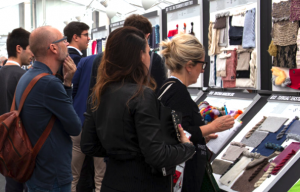
New yarns for knits area at Filo
Opinion


Autumn/winter 2017/18 sees a focus on richer colours, warm textures, tweeds and bouclés, according to the busy Filo Milan.
15th March 2016
Janet Prescott
|
Milan
Autumn/winter 2017/18 sees a focus on richer colours, warm textures, tweeds and bouclés and a focus on all things sustainable and ethical, according to the busy Filo Milan yarns exhibition held in March.
The fashion yarns for knitting included many luxury fibres, synthetic blends and a high proportion of wool used for both fancy looks and smooth thicker yarns for hand knitting in cashmere and wool. There was a wide variety of fibres for winter: Yarns were made in cotton, cotton with inject slubs, viscose and wool, Tencel, cashmere, silk, linen, Merino, with metallised yarns, and there were performance factors like Superwash, Zegna Baruffa’s H2 Dry wool, flame retardance and wicking effects which made this a show full of high tech, high value yarns which attracts specific buyers.
Bouclés, frisés, multi- coloured neps were twisted together in an exuberant collection of designs with both colour and texture. Shine and transparency were also important. Orteks of Turkey majored on shine, with Lurex, marls and random effects and stripes alternating matt and transparent bands, as well as micro examples of sparkle. Winter brights and pales like pink, orange, and the new focus on green - from light pistachio to deep grass green- light blue, white, dark navy, and greyed-off brights contributed to the feeling of energy and style in the trend area. Many bright colours were twisted with black for a mottled look, sometimes producing a punk effect. On the luxury end, fine yarns like Merino and silk were frequently twisted together and fancy knits with a lot of shine and glitter.
Colours were combined with two yarns twisted together, for example green and black, or grey and white for fine jersey with a random effect. Knitted fabric examples showed the impact of irregularity: random dyes, a lot of white mixed in for winter pales, and dark grounds with bright orange and yellow flashes of colour. Tape yarns gave an extra opportunity for knitting for texture and pattern with the fancy look which is in vogue. Hand knitted yarns in cashmere, soft wools, silk or acrylic with a soft handle were puffed up and cloudy for warmth and airy structures appeared in many collections.
Thicker natural-looking wool yarns and also richly coloured winter wool came from such specialists as Z Hinchliffe, with a large offering of stock colours in lambswool, as well as exotic pure baby camel which was also mixed with silk. Gardiner Yarns showed wool from protected species of British Herdwick sheep.
Mixed luxury tweeds were achieved by several mills, with combinations like extrafine Merino, cashmere and silk. Vintage tweed effects from Italian spinners as at also achieved a homespun effect from chunkier yarns, using cashmere too. Mottled looks, marbling, slubs and marls and irregular effects which reinforced the look of casual style: irregular, almost erroneous, different sized stitches gave a casual look, as at R Belda Llorens.
Eco certification by GOTS, and other ratifications of good practice, were widely flagged up as marks of quality and social responsibility. Orteks, one of the largest knitters in Turkey, are part of the Better Cotton Initiative. Marchi & Fildi introduced ECOTEC® billed as the first smart cotton, made in Italy from an exclusive, totally traceable and certified manufacturing process that turns100% pre-dyed cotton textile clippings into colourful ECOTEC® yarns.
This process means huge savings n terms of water, CO2 and energy, as attested by an LCA study conducted by ICEA which confirms improvements up to 56,3% for greenhouse gases, up to 56,6% in energy consumption and up to 77,9% in terms of water usage.
The contrast of matte effects with shiny yarns was on trend. Shine, through Lurex or lamé continues to appeal, with sparkle effects and metallic looks widespread. The Lurex Company itself, whose stand is always busy with important designers at Filo, showed matt effect yarns, holographic and fluorescent deep copper looks, purple and reds as well as iridescent and transparent yarns. New here was metallic yarn with flame retardant properties.
Linen is increasingly a winter fibre, not just when blended with wool silk. Safilin located near Lille, the heart of the linen producing area, showed fine pure linen yarns developed for knitting next-to-skin wear, identified by them as a growth area. They also reported an upsurge in the use of linen for menswear in particular, in knitted garments in various weights.
Spoerry the Swiss cotton producers, whose long staple cotton yarns are synonymous with luxury, also showed Re-Linen; the eco friendly fibre is from ecologically recycled rayon/ linen mixed with 15 per cent premium natural linen which gives a dry handle yarn with a sheen. Spoerry’s luxury cotton and cotton blends included a new collection of coloured yarns designed for circular and flat knitting, while its ice-cotton spinning produces pockets which can enhance capillary effects in the fabric.
Many yarns were evidently aimed at hand knits; soft wool, Merino type, cashmere, silk and blends while Safil and the Sudwolle Group newly united, have a wide range of circular knitting offers as well as hosiery collections. A new low pill jersey 50/50 wool/acrylic is the result of specific research carried out recently.
Technical features were widely quoted in booklets and labels, as at Pozzi Electa, with information on the advantages and workings of particular yarns. Most spinners emphasised the growth of their bespoke services, working with international designers and developers to produce unique products.
Filo was another international exhibition in 2016 which showed a positive attitude to prospects by both exhibitors and visitors, despite very difficult international conditions, citing research, high quality and customer service as their watchword.

Business intelligence for the fibre, textiles and apparel industries: technologies, innovations, markets, investments, trade policy, sourcing, strategy...
Find out more